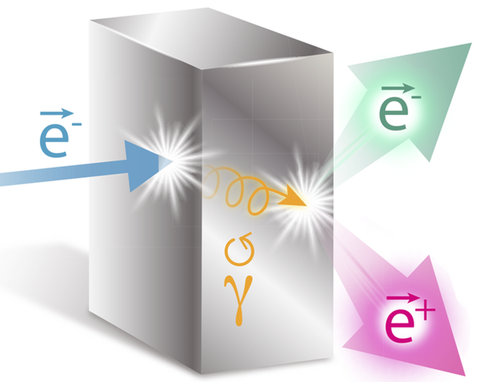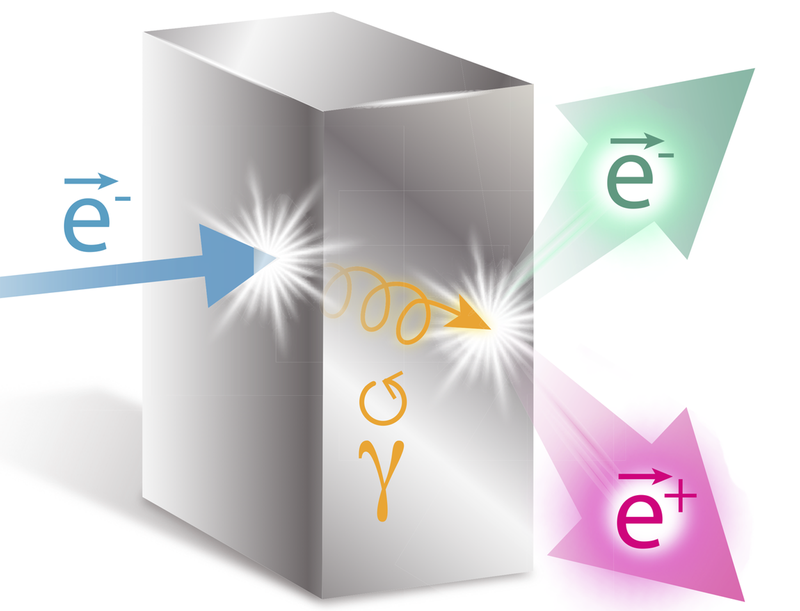Low Cost Polarized Positrons
The way an electron interacts with other particles often depends on its spin, and the same is true for the positron, the electron’s antimatter partner. A beam of polarized positrons, in which the majority of spins point in one direction, is the primary tool to study these effects. Now a team has demonstrated that such a beam can be created from a polarized electron beam having much less energy than earlier methods. The new technique offers a low-cost alternative for generating polarized positrons that could be used to probe materials in new ways.
Positrons with high energies in the GeV range can create new particles when collided with high-energy electrons, or they can act as a probe of the nucleus. At low energies (MeV and below), positrons can characterize defects and other features in materials by penetrating solids and annihilating with electrons to release observable gamma rays. A polarized positron beam, in which the spins are aligned, could provide more information, regardless of its energy. For example, it could probe the spin state of electrons within a ferromagnet or within a spintronic device (one that exploits electron spins rather than electron charges).
Two recent experiments produced polarized positron beams from circularly polarized light [1, 2]. Both of these techniques required high-energy (GeV) electron beams to generate the gamma rays that created the electrons and positrons. But such electron beams are only available at large accelerators. A new experiment, called PEPPo, for Polarized Electrons for Polarized Positrons, has now produced polarized positrons using a lower-energy electron beam (8 MeV). “Lower energy means lower cost, which makes the technology accessible to more people,” says PEPPo co-spokesperson Eric Voutier of the University of Paris-Sud in Orsay, France.
The PEPPo experiment, based at Jefferson Lab in Virginia, is able to work at lower energy because it creates gamma rays through a different mechanism. The researchers direct the electron beam, which has an initial polarization of around 85%, toward a 1-millimeter-thick tungsten target. The electrons collide with the tungsten nuclei, causing them to release so-called bremsstrahlung radiation in the form of circularly polarized MeV gamma rays.
When the gamma rays scatter off of tungsten nuclei, some of them produce electron-positron pairs. The polarized gamma rays lead to electrons and positrons that should also be polarized on average in the same direction as the initial electron beam. To verify this prediction, the researchers separated the electrons and positrons using magnetic fields and measured the positron polarization. It was as high as 82% for the highest energy positrons detected (6 MeV), implying nearly 100% transfer of the initial polarization. The positron polarization decreased to 40% at the lowest energy recorded (3 MeV).
The results are not too surprising. Theorists predicted over 50 years ago that polarization should transfer from electrons to photons and from photons to positrons through bremsstrahlung and electron-positron pair creation interactions. However, testing this prediction required electron beams with high polarization and high intensity, which only became available recently at places like Jefferson Lab and the Mainz Microtron in Germany. “PEPPo really stands on the shoulders of advances in polarized electron sources over the last few decades,” says PEPPo co-spokesperson Joe Grames from Jefferson Lab.
Voutier says the experiment was a proof-of-principle. “We now know that the transfer of polarization is efficient,” he says. But for many purposes, the positron beam will need to be more intense than the one PEPPo has produced so far. Grames says that positron beam intensity could be increased with higher energy or higher intensity in the input electron beam. Another option is a dedicated collection system that better uses magnetic fields to round up and focus the outgoing positrons.
Kirk McDonald of Princeton University says that the lower energy of the PEPPo method makes it more readily available for a wide range of uses than previous polarization methods for positrons. Atsuo Kawasuso from the National Institutes for Quantum and Radiological Science and Technology in Gunma, Japan, is impressed by the achieved polarization and says “many experiments will be possible” when the intensity is increased.
This research is published in Physical Review Letters.
–Michael Schirber
Michael Schirber is a Corresponding Editor for Physics Magazine based in Lyon, France.
References
- T. Omori et al., “Efficient Propagation of Polarization from Laser Photons to Positrons through Compton Scattering and Electron-Positron Pair Creation,” Phys. Rev. Lett. 96, 114801 (2006).
- G. Alexander et al., “Observation of Polarized Positrons from an Undulator-Based Source,” Phys. Rev. Lett. 100, 210801 (2008).





